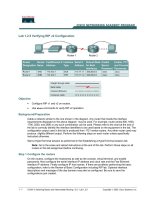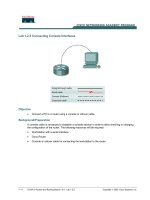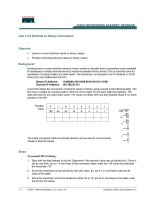Tài liệu Lab 1.2.5 Configuring DHCP pptx
Bạn đang xem bản rút gọn của tài liệu. Xem và tải ngay bản đầy đủ của tài liệu tại đây (261.72 KB, 6 trang )
Lab 1.2.5 Configuring DHCP
Objective
• Configure a router for Dynamic Host Configuration Protocol (DHCP) to dynamically assign
addresses to attached hosts.
Background/Preparation
Routing between the ISP and the campus router uses a static route between the ISP and the
gateway, and a default route between the gateway and the ISP. The ISP connection to the Internet is
identified by a loopback address on the ISP router.
Cable a network similar to the one in the diagram above. Any router that meets the interface
requirements displayed on the above diagram may be used. This includes the following and any of
their possible combinations:
• 800 series routers
• 1600 series routers
• 1700 series routers
• 2500 series routers
• 2600 series routers
1 - 6 CCNA 4: WAN Technologies v 3.0 - Lab 1.2.5 Copyright 2003, Cisco Systems, Inc.
Please refer to the chart at the end of the lab to correctly identify the interface identifiers to be used
based on the equipment in the lab. The configuration output used in this lab is produced from 1721
series routers. Any other router used may produce slightly different output. Conduct the following
steps on each router unless specifically instructed otherwise.
Start a HyperTerminal session as.
Note: Refer to the erase and reload instructions at the end of this lab. Perform those steps on all
routers in this lab assignment before continuing.
Step 1 Configure the routers
Configure all of the following according to the chart:
• The hostname
• The console
• The virtual terminal
• The enable passwords
• The interfaces
If problems occur during this configuration, refer to the Network Address Translation (NAT)
configuration lab.
Step 2 Save the configuration
At the privileged exec mode prompt, on both routers, type the command copy running-config
startup-config.
Step 3 Create a static route
a. Addresses 199.99.9.32/27 have been allocated for Internet access outside of the company. Use
the ip route command to create the static route:
ISP(config)#ip route 172.16.12.0 255.255.255.0 172.16.1.6
b. Is the static route in the routing table?
___________________________________________
Step 4 Create a default route
a. Use the ip route command to add a default route from the campus router to the ISP router.
This will provide the mechanism to forward any unknown destination address traffic to the ISP:
campus(config)#ip route 0.0.0.0 0.0.0.0 172.16.1.5
b. Is the static route in the routing table?
___________________________________________
Step 5 Create the DHCP address pool
To configure the campus LAN pool, use the following commands:
campus(config)#ip dhcp pool campus
campus(dhcp-config)#network 172.16.12.0 255.255.255.0
campus(dhcp-config)#default-router 172.16.12.1
campus(dhcp-config)#dns-server 172.16.1.2
campus(dhcp-config)#domain-name foo.com
campus(dhcp-config)#netbios-name-server 172.16.1.10
2 - 6 CCNA 4: WAN Technologies v 3.0 - Lab 1.2.5 Copyright 2003, Cisco Systems, Inc.
Step 6 Excluding addresses from pool
To exclude addresses from the pool, use the following commands:
campus(dhcp-config)#ip dhcp excluded-address 172.16.12.1 172.16.12.10
Step 7 Verifying DHCP Operation
a. At each workstation on the directly connected subnet configure the TCP/IP properties so the
workstation will obtain an IP address and Domain Name System (DNS) server address from the
DHCP server. After changing and saving the configuration, reboot the workstation.
b. To confirm the TCP/IP configuration information on each host use Start > Run > winipcfg. If
running Windows 2000, check using ipconfig in a DOS window.
c. What IP address was assigned to the workstation?
_________________________________
d. What other information was automatically assigned?
________________________ ________________________ ________________________
e. When was the lease obtained?
________________________________________________
f. When will the lease expire?
__________________________________________________
Step 8 View DHCP bindings
a. From the campus router, the bindings for the hosts can be seen. To see the bindings, use the
command show ip dhcp binding at the privileged exec mode prompt.
b. What were the IP addresses assigned?
_________________________________________
c. What are the three other fields listed in the output?
________________________ ________________________ ________________________
Upon completion of the previous steps finish the lab by doing the following:
• Logoff by typing exit
• Turn the router off
3 - 6 CCNA 4: WAN Technologies v 3.0 - Lab 1.2.5 Copyright 2003, Cisco Systems, Inc.
• Remove and store the cables and adapter
4 - 6 CCNA 4: WAN Technologies v 3.0 - Lab 1.2.5 Copyright 2003, Cisco Systems, Inc.
Erasing and reloading the router
Enter into the privileged exec mode by typing enable.
If prompted for a password, enter class (if that does not work, ask the instructor).
Router>enable
At the privileged exec mode enter the command erase startup-config.
Router#erase startup-config
The responding line prompt will be:
Erasing the nvram filesystem will remove all files! Continue? [confirm]
Press Enter to confirm.
The response should be:
Erase of nvram: complete
Now at the privileged exec mode enter the command reload.
Router(config)#reload
The responding line prompt will be:
System configuration has been modified. Save? [yes/no]:
Type n and then Enter
The responding line prompt will be:
Proceed with reload? [confirm]
Press Enter to confirm.
In the first line of the response will be:
Reload requested by console.
After the router has reloaded the line prompt will be:
Would you like to enter the initial configuration dialog? [yes/no]:
Type n and then Enter.
The responding line prompt will be:
Press RETURN to get started!
Press Enter.
Now the router is ready for the assigned lab to be performed.
5 - 6 CCNA 4: WAN Technologies v 3.0 - Lab 1.2.5 Copyright 2003, Cisco Systems, Inc.









